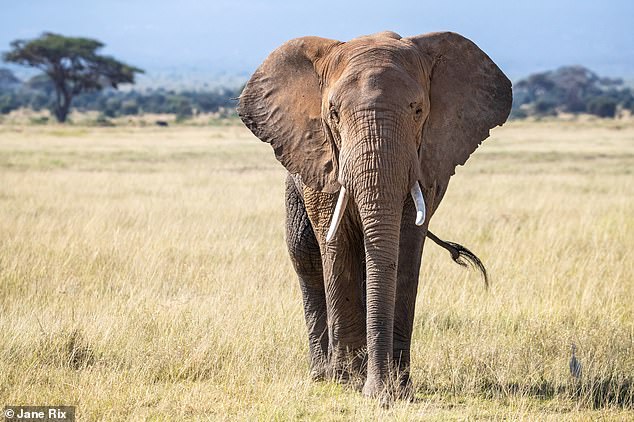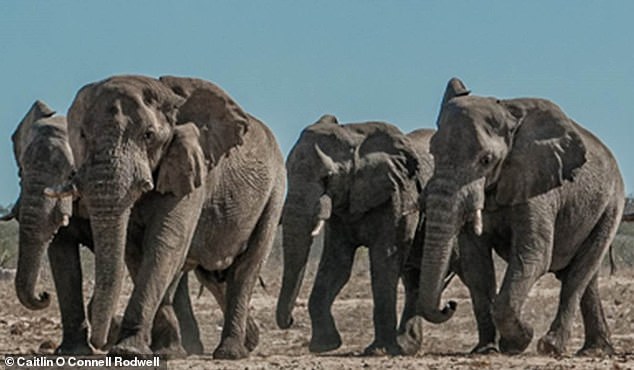The secret language of elephants: Males use deep rumbles to signal ‘let’s go’ to their pals, study finds
Elephants are known for their remarkably human intelligence.
But new research shows that males in groups convey a sophisticated message, even if it sounds like a primitive growl to human ears.
According to experts, adult male African elephants emit a deep, resonant growl to their herdmates to signal that it is time to move to another location.
The biologists have made a stunning audio recording showing that this so-called ‘let’s go rumble’ sound is repeated by the entire herd, ‘like a barbershop quartet’.
Adult females are already known to use the ‘let’s go rumble’, but new recordings document the technique in males for the first time.
Scientists have recorded male elephants using ‘let’s go’ roars to signal the beginning of the group’s departure
The new research was led by Caitlin O’Connell-Rodwell, a research associate at Stanford University’s Center for Conservation Biology.
“This call shows us that there is much more going on in their vocal communication than we previously knew,” she said.
The experts studied African forest elephants (Loxodonta africana) at the Mushara waterhole in Namibia’s Etosha National Park, one of the largest national parks in Africa.
Although the African forest elephant is a social mammal that lives in herds, these groups consist of females and their offspring.
Males leave the herd when they reach maturity – around 10 to 19 years of age – and as adults they usually live alone or in small ‘bachelor’ groups.

The experts studied elephants at the Mushara waterhole in Etosha National Park, Namibia, one of the largest national parks in Africa

African forest elephant males (pictured) leave the herd when they reach maturity – around 10 to 19 years of age – and as adults they usually live alone or in small ‘bachelor’ groups
In Etosha National Park, experts used recording equipment, including buried microphones and night-vision cameras, to capture movements and sounds inaudible to the human ear.
They noted that the distinctive rumbling sound preceded the departure from the waterhole, indicating that it had significant meaning.
Normally, the rumble would come first from the oldest or dominant male in the group, with the other males repeating it as if in agreement.
Each elephant waited until the previous call was almost finished before adding its own call, creating a harmonious, alternating pattern that resembled a quartet in a barbershop.
The findings are particularly surprising because men tend to have loose social ties, O’Connell-Rodwell and colleagues said.
“We found that this vocal coordination occurs in groups of closely associated individuals, and rarely between looser companions,” they say.
The “let’s go” rumble observed in male elephants shows striking similarities to the rumble previously observed in female elephants.
The team hypothesizes that male elephants likely learn this behavior when they are young, before they leave the herd.
“They grew up in a family where all the female leaders participated in this ritual,” O’Connell-Rodwell said.

Three spectrograms showing coordinated departure rumble vocalizations by three different male elephants. A spectrogram is a graph that shows the strength of a signal over time for a given frequency range

Male elephants, typically thought of as having loose social ties, use such advanced vocal coordination to trigger action
‘We think that as they mature and form their own groups, they adapt this learned behavior and use it to cooperate with other males.’
Sadly, African elephant populations have declined dramatically over the past century due to poaching, revenge attacks for crop raiding, and habitat fragmentation.
Care must be taken to ensure that older male elephants that have good community ties are not hunted. If they are removed, it can disrupt social cohesion and mentoring structures within elephant populations.
“These findings provide further support for the proposition that adult males, and perhaps certain individuals such as those leading the LGR events here, are important to male elephant society,” the team writes in their paper, published in PeerJ.
‘There are also other variables, such as group size, level of clutter and degree of connectedness, that may influence the duration of departure and warrant further investigation.’
Another recent study found that African forest elephants call each other by name. In other words, they use unique sounds depending on which elephant they are communicating with.
The findings suggest that elephants may be capable of abstract thought, making them much more socially complex mammals than previously thought.
